#worldbuilding races
Text
More worldbuilding infodumps
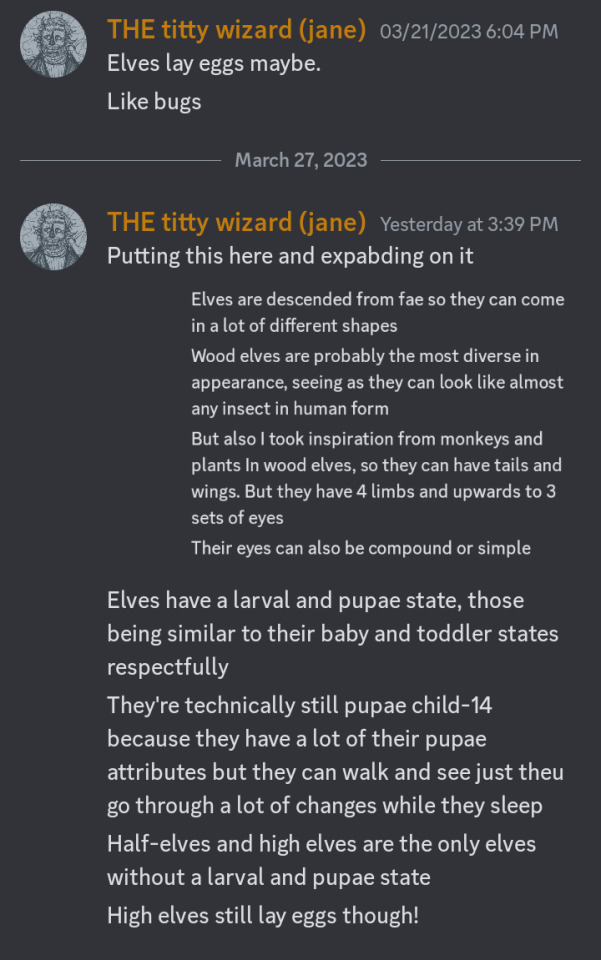
#worldbuilding races#world building#worldbuilding#elves#high elf#high elves#elfs#elf#dark elf#dark elves#wood elf#wood elves#fantasy worldbuilding
27 notes
·
View notes
Text
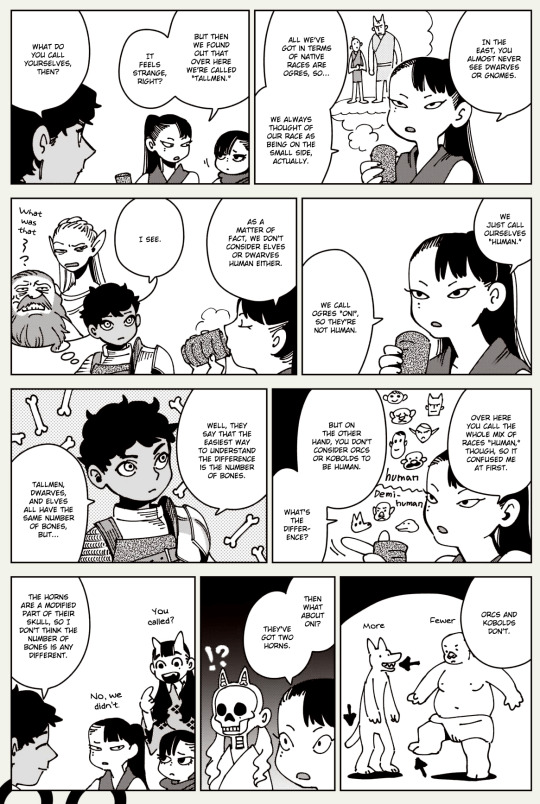
Dungeon Meshi - Humans and Demi-Humans
7K notes
·
View notes
Text
How Do I Make My Fictional Gypsies Not Racist?
(Or, "You can't, sorry, but…")
You want to include some Gypsies in your fantasy setting. Or, you need someone for your main characters to meet, who is an outsider in the eyes of the locals, but who already lives here. Or you need a culture in conflict with your settled people, or who have just arrived out of nowhere. Or, you just like the idea of campfires in the forest and voices raised in song. And you’re about to step straight into a muckpile of cliches and, accidentally, write something racist.
(In this, I am mostly using Gypsy as an endonym of Romany people, who are a subset of the Romani people, alongside Roma, Sinti, Gitano, Romanisael, Kale, etc, but also in the theory of "Gypsying" as proposed by Lex and Percy H, where Romani people are treated with a particular mix of orientalism, criminalisation, racialisation, and othering, that creates "The Gypsy" out of both nomadic peoples as a whole and people with Romani heritage and racialised physical features, languages, and cultural markers)
Enough of my friends play TTRPGs or write fantasy stories that this question comes up a lot - They mention Dungeons and Dragons’ Curse Of Strahd, World Of Darkness’s Gypsies, World Of Darkness’s Ravnos, World of Darkness’s Silent Striders… And they roll their eyes and say “These are all terrible! But how can I do it, you know, without it being racist?”
And their eyes are big and sad and ever so hopeful that I will tell them the secret of how to take the Roma of the real world and place them in a fictional one, whilst both appealing to gorjer stereotypes of Gypsies and not adding to the weight of stereotyping that already crushes us. So, disappointingly, there is no secret.
Gypsies, like every other real-world culture, exist as we do today because of interactions with cultures and geography around us: The living waggon, probably the archetypal thing which gorjer writers want to include in their portrayals of nomads, is a relatively modern invention - Most likely French, and adopted from French Showmen by Romanies, who brought it to Britain. So already, that’s a tradition that only spans a small amount of the time that Gypsies have existed, and only a small number of the full breadth of Romani ways of living. But the reasons that the waggon is what it is are based on the real world - The wheels are tall and iron-rimmed, because although you expect to travel on cobbled, tarmac, or packed-earth roads and for comparatively short distances, it wasn’t rare to have to ford a river in Britain in the late nineteenth century, on country roads. They were drawn by a single horse, and the shape of that horse was determined by a mixture of local breeds - Welsh cobs, fell ponies, various draft breeds - as well as by the aesthetic tastes of the breeders. The stove inside is on the left, so that as you move down a British road, the chimney sticks up into the part where there will be the least overhanging branches, to reduce the chance of hitting it.
So taking a fictional setting that looks like (for example) thirteenth century China (with dragons), and placing a nineteenth century Romanichal family in it will inevitably result in some racist assumptions being made, as the answer to “Why does this culture do this?” becomes “They just do it because I want them to” rather than having a consistent internal logic.
Some stereotypes will always follow nomads - They appear in different forms in different cultures, but they always arise from the settled people's same fears: That the nomads don't share their values, and are fundamentally strangers. Common ones are that we have a secret language to fool outsiders with, that we steal children and disguise them as our own, that our sexual morals are shocking (This one has flipped in the last half century - From the Gypsy Lore Society's talk of the lascivious Romni seductress who will lie with a strange man for a night after a 'gypsy wedding', to today's frenzied talk of 'grabbing' and sexually-conservative early marriages to ensure virginity), that we are supernatural in some way, and that we are more like animals than humans. These are tropes where if you want to address them, you will have to address them as libels - there is no way to casually write a baby-stealing, magical succubus nomad without it backfiring onto real life Roma. (The kind of person who has the skills to write these tropes well, is not the kind of person who is reading this guide.)
It’s too easy to say a list of prescriptive “Do nots”, which might stop you from making the most common pitfalls, but which can end up with your nomads being slightly flat as you dance around the topics that you’re trying to avoid, rather than being a rich culture that feels real in your world.
So, here are some questions to ask, to create your nomadic people, so that they will have a distinctive culture of their own that may (or may not) look anything like real-world Romani people: These aren't the only questions, but they're good starting points to think about before you make anything concrete, and they will hopefully inspire you to ask MORE questions.
First - Why are they nomadic? Nobody moves just to feel the wind in their hair and see a new horizon every morning, no matter what the inspirational poster says. Are they transhumant herders who pay a small rent to graze their flock on the local lord’s land? Are they following migratory herds across common land, being moved on by the cycle of the seasons and the movement of their animals? Are they seasonal workers who follow man-made cycles of labour: Harvests, fairs, religious festivals? Are they refugees fleeing a recent conflict, who will pass through this area and never return? Are they on a regular pilgrimage? Do they travel within the same area predictably, or is their movement governed by something that is hard to predict? How do they see their own movements - Do they think of themselves as being pushed along by some external force, or as choosing to travel? Will they work for and with outsiders, either as employees or as partners, or do they aim to be fully self-sufficient? What other jobs do they do - Their whole society won’t all be involved in one industry, what do their children, elderly, disabled people do with their time, and is it “work”?
If they are totally isolationist - How do they produce the things which need a complex supply chain or large facilities to make? How do they view artefacts from outsiders which come into their possession - Things which have been made with technology that they can’t produce for themselves? (This doesn’t need to be anything about quality of goods, only about complexity - A violin can be made by one artisan working with hand tools, wood, gut and shellac, but an accordion needs presses to make reeds, metal lathes to make screws, complex organic chemistry to make celluloid lacquer, vulcanised rubber, and a thousand other components)
How do they feel about outsiders? How do they buy and sell to outsiders? If it’s seen as taboo, do they do it anyway? Do they speak the same language as the nearby settled people (With what kind of fluency, or bilingualism, or dialect)? Do they intermarry, and how is that viewed when it happens? What stories does this culture tell about why they are a separate people to the nearby settled people? Are those stories true? Do they have a notional “homeland” and do they intend to go there? If so, is it a real place?
What gorjers think of as classic "Gipsy music" is a product of our real-world situation. Guitar from Spain, accordions from the Soviet Union (Which needed modern machining and factories to produce and make accessible to people who weren't rich- and which were in turn encouraged by Soviet authorities preferring the standardised and modern accordion to the folk traditions of the indigenous peoples within the bloc), brass from Western classical traditions, via Balkan folk music, influences from klezmer and jazz and bhangra and polka and our own music traditions (And we influence them too). What are your people's musical influences? Do they make their own instruments or buy them from settled people? How many musical traditions do they have, and what are they all for (Weddings, funerals, storytelling, campfire songs, entertainment...)? Do they have professional musicians, and if so, how do those musicians earn money? Are instrument makers professionals, or do they use improvised and easy-to-make instruments like willow whistles, spoons, washtubs, etc? (Of course the answer can be "A bit of both")
If you're thinking about jobs - How do they work? Are they employed by settled people (How do they feel about them?) Are they self employed but providing services/goods to the settled people? Are they mostly avoidant of settled people other than to buy things that they can't produce themselves? Are they totally isolationist? Is their work mostly subsistence, or do they create a surplus to sell to outsiders? How do they interact with other workers nearby? Who works, and how- Are there 'family businesses', apprentices, children with part time work? Is it considered 'a job' or just part of their way of life? How do they educate their children, and is that considered 'work'? How old are children when they are considered adult, and what markers confer adulthood? What is considered a rite of passage?
When they travel, how do they do it? Do they share ownership of beasts of burden, or each individually have "their horse"? Do families stick together or try to spread out? How does a child begin to live apart from their family, or start their own family? Are their dwellings something that they take with them, or do they find places to stay or build temporary shelter with disposable material? Who shares a dwelling and why? What do they do for privacy, and what do they think privacy is for?
If you're thinking about food - Do they hunt? Herd? Forage? Buy or trade from settled people? Do they travel between places where they've sown crops or managed wildstock in previous years, so that when they arrive there is food already seeded in the landscape? How do they feel about buying food from settled people, and is that common? If it's frowned upon - How much do people do it anyway? How do they preserve food for winter? How much food do they carry with them, compared to how much they plan to buy or forage at their destinations? How is food shared- Communal stores, personal ownership?
Why are they a "separate people" to the settled people? What is their creation myth? Why do they believe that they are nomadic and the other people are settled, and is it correct? Do they look different? Are there legal restrictions on them settling? Are there legal restrictions on them intermixing? Are there cultural reasons why they are a separate people? Where did those reasons come from? How long have they been travelling? How long do they think they've been travelling? Where did they come from? Do they travel mostly within one area and return to the same sites predictably, or are they going to move on again soon and never come back?
And then within that - What about the members of their society who are "unusual" in some way: How does their society treat disabled people? (are they considered disabled, do they have that distinction and how is it applied?) How does their society treat LGBT+ people? What happens to someone who doesn't get married and has no children? What happens to someone who 'leaves'? What happens to young widows and widowers? What happens if someone just 'can't fit in'? What happens to someone who is adopted or married in? What happens to people who are mixed race, and in a fantasy setting to people who are mixed species? What is taboo to them and what will they find shocking if they leave? What is society's attitude to 'difference' of various kinds?
Basically, if you build your nomads from the ground-up, rather than starting from the idea of "I want Gypsies/Buryats/Berbers/Minceiri but with the numbers filed off and not offensive" you can end up with a rich, unique nomadic culture who make sense in your world and don't end up making a rod for the back of real-world cultures.
5K notes
·
View notes
Text
I LOVE Dungeon Meshi's Realistic Fantasy Races
Ok, I had to stop for a moment to gush about the fantasy races of Dunmeshi, and all the consideration that's been put into them, because they actually follow a degree of natural/evolutionary logic not found in most fantasy stories!
Half-Foots (halflings/hobbits):

So we all know these fellows have excellent hearing and smell, but have you considered WHY? It's an adaptation to counteract their size. Humans (called tallmen in this setting) rely so much on eyesight because we're really tall compared to most animals, giving us a fantastic vantage of our environment. Half-Foots don't have this advantage, and therefore rely on their other senses. It's also much more important for them to be able to detect unseen threats and move quickly, because their size makes them ill-equipped for direct conflict.
Dwarves:
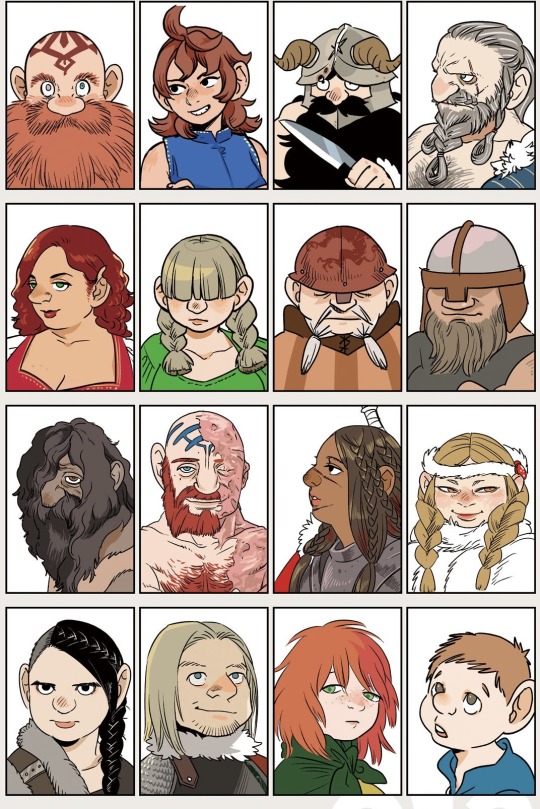
So Dwarves are depicted as MUCH stronger than tallmen despite their size, right? This is because strength is determined not by size, but by mass, and dwarven bodies are very dense! Yet this comes with the downside of their bodies burning more energy and overheating much faster, which is why dwarves are also shown to be heat-resistant, and why they tend to wear lighter clothing that exposes more skin! Their night-vision is also better than humans' due to their semi-underground lifestyle, while their hearing remains about the same since sound naturally carries in caves. Their hairiness is also likely a direct adaptation to counteract magic, as it's been shown to form a natural buffer when left unwashed.
Gnomes:
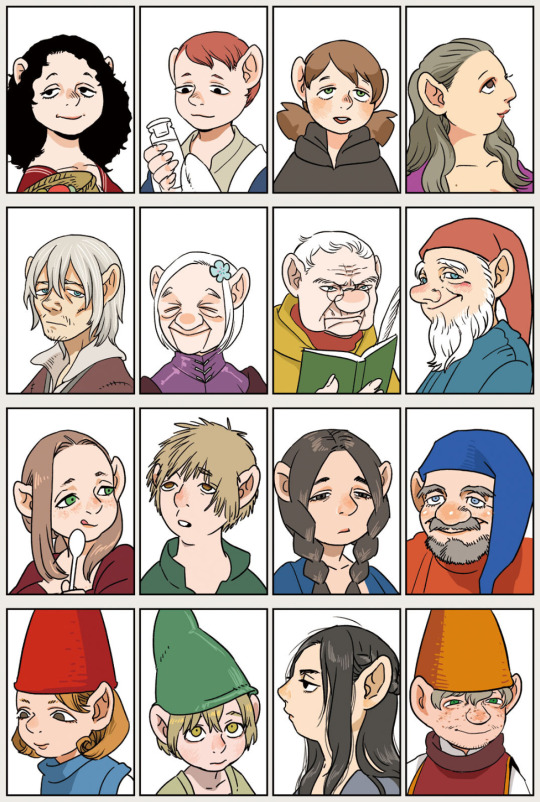
Gnomes are supposed to be evolutionary cousins to dwarves, and it shows! They share a similar height, but are less muscular and have peculiarly-shaped ears, almost mirroring the difference between human and elven ears. Their affinity with nature and spirits also makes sense, because physically they're in an awkward spot compared to the other short races, lacking both the hefty strength of dwarves and the light nimbleness of half-foots. Being less equipped both for fight and flight, it makes sense they'd instead adapt the instinctive ability to read their environments and mitigate its threats through cohabitation.
Elves:

Like gnomes, elves are in a physically awkward place, however it's even more extreme. Their relatively light and weak bodies make them ill-equipped for direct conflict, and while likely able to move faster than tallmen due to weight, they lack the half-foot's danger-detection senses. This makes them seemingly helpless, however interestingly it actually explains why they're so advanced compared to other races! They were basically forced to coordinate problem-solve, and control their environments out of necessity, which is reflected in their more controlling and direct relationship with magic and nature compared to gnomes.
This actually mirrors the real-world difference between humans and neanderthals. Anthropologists believe neanderthals weren't actually dumber than humans, but that their superior strength and durability meant they weren't forced to problem-solve or control their environments like humans, meaning they seemed less advanced.
2K notes
·
View notes
Text
There's an orc attending your college. Your city is pretty diverse, there's a lot of human cultures represented there, and even harpies and dwarves are common. But an orc is still a really rare sight. And she's not assimilated at all, she wears the symbol of the dark lord around her neak, and the strange black cloths from the wastelands she came from, and she always seems to have a gun somewhere on her. It's strange just to see an orc in person, she's not like the green skinned monsters you see in movies, her eyes are pitch black, and her skin is so pale you can see veins, she's muscular and tell but also strangely skinny, and her teeth are sharp and spiked like a sharks, this one doesn't have tusks, just these rows of serrated teeth.
Everyone avoids her at first. There's something creepy about her. She doesn't move like a human. She emotes weirdly, being stoic during conversations, but sometimes smiling or laughing at odd times. In class it becomes clear that she lacks knowledge anyone growing up in your society has, but has extensive knowledge on things most humans will never know. She also very clearly supports the dark lord and the demons who serve him, and gets mad when his narrative of conquest and strict genetic hierarchy is challenged in class.
You end up paired with her for a class project. It's weirdly awkward. But you end up spending more time with her then most. It still takes awhile to get used to her mannerisms, and you have to convince her of evolution in a long debate (but eventually you do convince her). She seems strangely naive to a lot of things. Every time she does something that she considers a failure she goes into self loathing, and she gets really afraid she's going to be punished. You have to explain to her things are going to be ok sometimes.
You try to spend time with her. She supports the dark lord but out of a strange sense of fear more than the type of ideological support humans in nations not under his control have. When she does something that she thinks is heresy agaisnt him she becomes afraid. And while she's angry at people who follow gods other than him (which is basically everyone here) she's more afraid of them than everything. When a holy symbol you own touches her she's surprised it doesn't burn her, you have to tell her it's ok.
She has a lot more freedom here than she did back in the wastelands. You slowly help her realize she doesn't have to worry about being punished for sinning agasint the dark lord. She's able to go on the internet for the first time, you help her get everything set up. You also introduce her to your freinds, only some of whom feel safe around her, but those who do seem to like her.
It's weird just hanging out in her dorm. She can be weirdly laid back and introspective at times, at least when she's not nervous or paranoid. But when she's just relaxing she'll tell you about things, about the beauty of the desert sands, about what it was like to observe the rattlesnakes and condors and wyverns of her homeland. How she likes to observe the city, the way the diffrent people flow through it, she was scared of it at first but now she likes to explore it, and the way it lacks stars at night but the lights from the buildings replace it. She says she wishes she could stay here forever, that she wishes she could be an artist but that she was sent here to learn skills useful to the dark lord's empire.
There's something nice about showing her new things. You get to take her to a musical for the first time. Get to show her neighborhoods you like. Get to explain to her what public transport is (though she got scared feeling trapped in a subway car). You get to show her stuff she never got to experience because orcs are never really children, she loves getting to hold a plush for the first time, or watching cartoons for the first time, it's like she's finally getting to live an experience she never had. Even though she's a well armed adult she really likes plushies once she finds out about them, they weren't something she was allowed to have back home.
Over time she starts meeting people and learning things that go against her worldview. As she makes more friends, understands new things, slowly learns that she shouldn't be punished for mistakes, she slowly comes around to seeing how fucked up the world the was raised in is. She tells you she doesn't want to worship the dark lord anymore, she cries just from saying it. You hug her, and realize she's never been hugged before, she seems to really like that feeling. She bathes in the waters of a healing goddess, and she worships something out of love instead of fear for the first time.
Eventually the spawning warlock who spawned her and her siblings comes to visit her. You told her to be careful but she ended up spilling that she doesn't worship the dark lord, she ends up spilling all the things a warlock like that considers a sin. When he leaves she tells you she can't go home. Not ever. Never again will she see the shifting sands, or flying condor, or flowing serpents of her homelands. She's trapped where she is now.
You know it hurts her a lot. She says she feels like she's in a small pocket of safety. Back home she'd be hurt for being an apostate. In human lands outside of the city she'd be hurt for being an orc. But she's safe here. She stays in her apartment for awhile, while you try to make things work. She's finally changing her major to art, and despite everything she's finally free, free to watch the starless sky, free to not be punished when she makes a mistake...
#196#my thougts#worldbuilding#writing#my worldbuilding#my writing#fantasy#urban fantasy#original fiction#flash fiction#short story#short fiction#orcs#orc girl#orc#magical realism#dark lord#dark fantasy#sympathetic monster#redemption arc#demons#fantasy races#fantasy writing#fantasy world#fantasy worldbuilding#orc rights#ex christian#ex evangelical#anti christianity
173 notes
·
View notes
Text


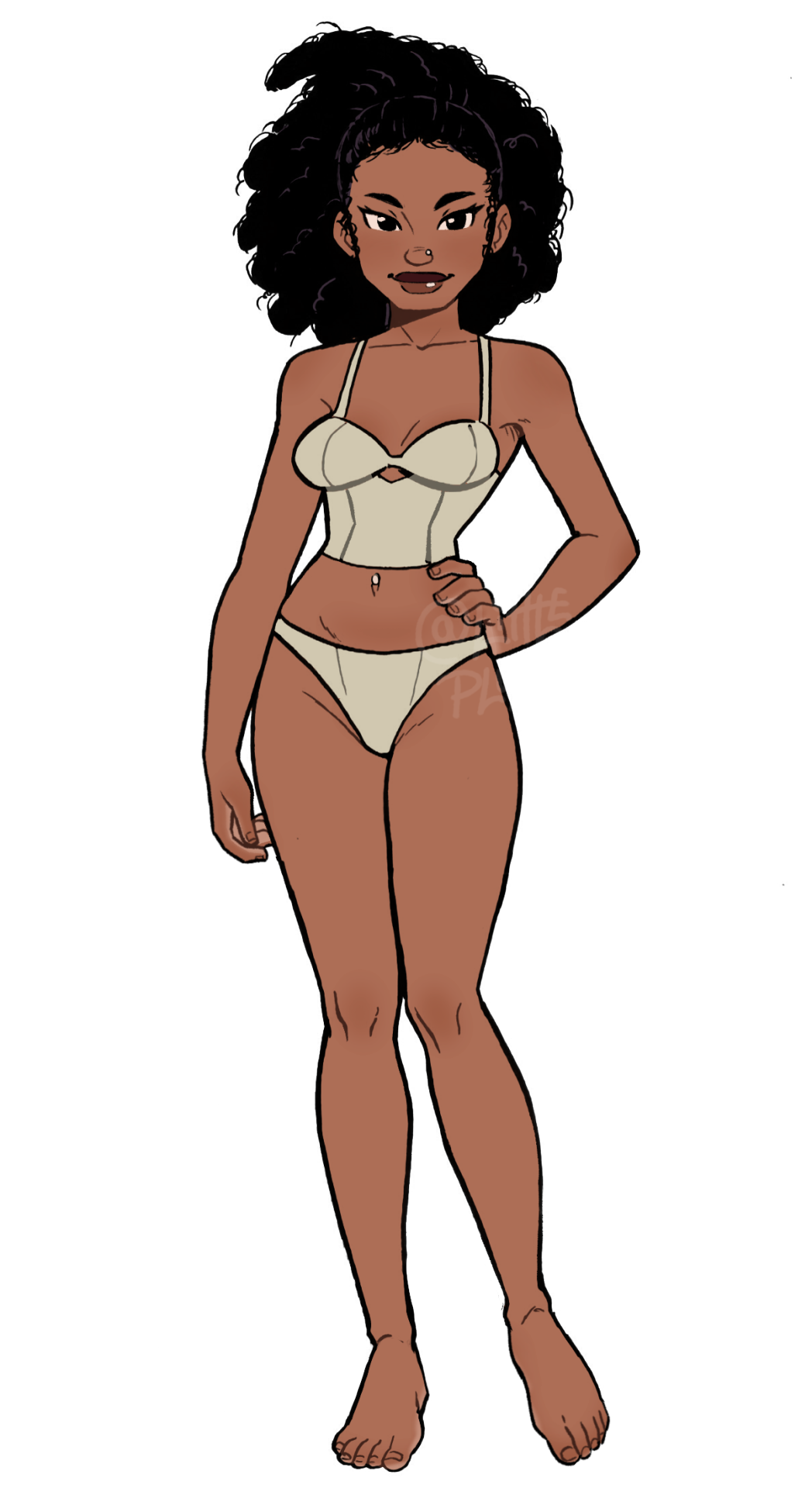


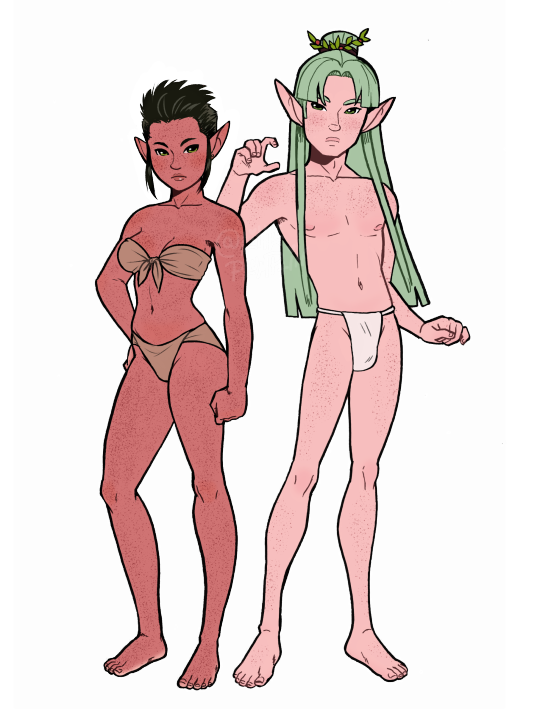




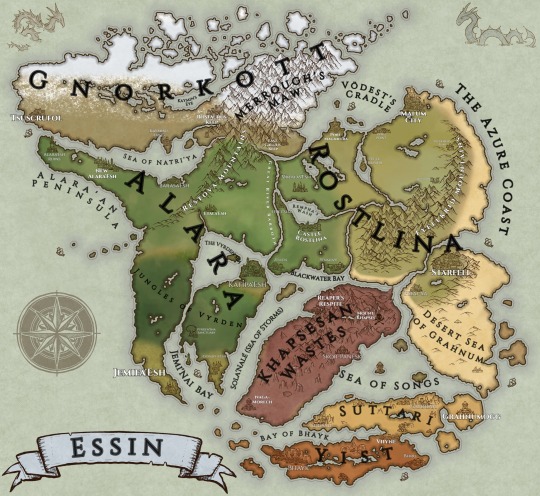
Welcome to Essin! Home to many different peoples. From the small, humble Bumpkins, to the towering, powerful Orcs. We hope you find them all interesting!
My Husband and I have been brainstorming the fantasy world of Essin for over 2 years now and are so excited to bring this world to life (as much as two people reasonably can, that is), but feel free to ask all about them! We have a bunch of lore we're happy to share!
Oh, and make sure to peep the alt text on each pic, as there's much lore tucked away in there!
#fantasy world#worldbuilding#fantasy art#fantasy races#original fantasy#original art#digital art#character design#Essin#halflings#orcs#trolls#fantasy humans#Trogs#Bumpkins#Drosskin#fae#goblins#elves#wood elves#high elves#my art
783 notes
·
View notes
Text
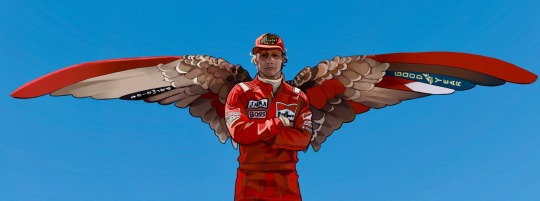
Sponsorships
ever since it was suggested to me i’ve wanted to draw Niki with his sponsored replacement feathers..and yes I gave up and made both P1s red because i think he looks cool
- -
The title page of a magazine article about Niki’s choice. As the first major figure in F1 to turn prosthetic feathers into advertising space, he got quite a bit of attention from journalists (much to his chagrin)

#egg’s art#f1#i’m very fond of adding the good year blue..maybe more colors?#an addendum to my ‘how do racers deal with feather damage’ post#f1 wing au#f1 jet pack racing au#formula one#niki lauda#classic f1#worldbuilding#still on my bird nerd shit
148 notes
·
View notes
Note
Are Merch Mimics capable of using assimilation offensively against humans, for self-defense and otherwise? Like, if someone tried to break a toy/game/etc they were inhabiting, could the Mimic instead pull them in?
To a degree, yeah. I should mention though that Victor isn't "in" the TV in any magical sense; spoiler alert: he's the controller Vance is holding! Hence, the eye on the controller reacting to the dialogue. The Victor on the screen is actualy a model he rigged for a homebrew game he coded the old fashioned way, which responds to whatever inputs the controller sends to the Wii.
He actually is an active member of the homebrew community, and loves to mess with electronics the old fashioned way. Almost no one on the forums knows he's a toy bird, but are impressed nonetheless with his little projects, various rail-shooter games, and weird obsession with snarky anthropomorphic birds.
Victor could technically "jump into a game" on a tv screen, but it'd be a bit of a weird process if he doesn't know how to mod the game, so it'd look more like a shitty greenscreen effect rather than anything coherent. He'd need to learn in real time how the game is coded, how to inject arbitrary code into the system while it's running, etc etc. He CAN do that because he's a fucking NERD, but it wouldn't be a quick process at all.
I should also mention, mimics have an inherent ability to create dreams, since they come about from processing the thoughts and ideas of humans. If a human bonds with a mimic, such that the mimic now knows how the human thinks, they can pull a (somewhat) willing human into the dream when the human sleeps. So to wrap this all up: what Victor could do for a game he understands inside and out is pull a human into a dream that happens to match whatever he himself experiences as currently going on in the game. Basically the ultimate VR experience, with the mimic as a middle-man. Which might be something that'll happen in the comic soon....!
So that all seems a bit convoluted, right? Here's even more worldbuilding about matter assimilation by mimics below the cut. Stop here if you don't want a headache.
The reason so many hoops would be needed to pull a human into a game world is that assimilation is much easier on inert, inanimate objects that are not currently "in use" by a thinking thing, or something that relies on constant electrical signals to function. This can be something with brainwaves, or some other kind of animation like a normal robot. A mimic can convert a CRT TV that's turned off somewhat easily, but a TV that's turned on, with particles of every kind constantly moving into and out of it, is much harder to convert.
This means that humans and biological creatures in general are also trickier to convert, though it can still happen if done gradually enough. Hence, Victor wouldn't be able to rapidly convert Vance in one fell swoop, it'd be a whole process. It's easier to just pull a human into a dream instead, and if a mimic undersrands a video game, or a story in a book really well, they can basically make the fictional world into an extremely lucid reality for whatever human tags along with them.
I often describe mimics as just "jojo stands if they were corporeal and could just get up and move around on their own with no user"; you know how in jojo stand battles or old stories about magic curses, if you break the curse or kill the stand before its effect becomes permanent, all of the damage is magically undone? Like if you kill Green Day, the mold stand, all of the molding just instantly stops?
Mimics who use their powers of assimilation offensively work similarly; they can project their influence to a certain range, and partially assimilate matter in that range. If you knock out or kill the mimic, however, everything reverts to normal. A human who doesn't want to get converted can basically just turn around and walk away most of the time, or shoot the mimic, so the mimic in question needs to pull off some trick to get the human to stay within range for the assimilation to fully stick. A human can still break free and get out of range even if fully converted, but it's much harder, as assimilation usually means the mimic gaining greater control over the converted object in question. The exact range and effect mimics have is again like jojo stand ranges; it varies.
Different mimics have different affinities for different things. Victor can assimilate cheap electronics fastest because he likes them and understands how they work (it's why he's a toy bird mp3 player). Az can assimilate guns, and turn ammo into weird anomalous ammo with weird effects. Zachary is a genius who can assimilate any matter, including biological matter, faster than anyone... but he's also extremely picky and hates the sight of blood, so he only uses assimilation on things he really, really likes.
If I could somehow make another read more at this point, I would. It's gonna get messy:
What a weird power and setup though, right? Why? The true nature of mimics is unknown to most of them, but the deepest lore is that the first mimics were constructs made by a people long ago, who first made them as highly advanced machines that'd recognize the thoughts of their masters to fulfill any practical desire. Need a road built? Done. Need a ship repaired? Done. With physical needs all met, the people began to turn inward, and use the mimics to illustrate their own artistic ideas. Eventually, the will and consciousness of these people were assimilated and inherited by mimics, who themselves became people. Mimics spread, altered themselves, duplicated, deviated, fused, split, and wandered around. Getting into recreational wars, manifesting horrors and delights into reality because they could.
Somehow, after the dust settled, the strongest mimics, the angels, decide to set their sights to the stars, and observe other lifeforms develop technology and their own art. Did mimics come to earth millions of years ago, and simply watched humans grow, evolving with them in-tandem? Or did humans make the first mimics, and somehow became undone and set back to the stone age? The answer to this mystery is currently known only to the oldest of mimics. Except Zachary. He's old, but didn't care to remember.
This is generally why mimics seem so compatible with humans; they were made by either them, or people who were, for whatever the reason, very much like them, flaws and all. The ability to assimilate is basically the conversion of matter into a more malleable state of information. A virtually magical power, but this was achieved not through prayers and spells, but a very human-like obsession with developing technology to the point of exerting control over molecules, then atoms, then the lowest planks of matter. The obsession with scaling every mountain and crossing through every valley. To rip the natural world apart, and hopefully, put it back together before it's too late. Angels seek to ensure humanity walks the right path there, but with human's own desires and intent honored, for better or worse.
To answer your question: yes. A mimic of Mario can pull you into the game and you can jump with him and eat shitty low poly spaghetti with him.
The process for doing that is just convoluted and complicated, and you need to get to know each other a bit first. If he tries to use it as an attack though, it either won't work, or it might just wind up giving you mild brain damage.
82 notes
·
View notes
Text

Idk if this has been posted here before but I just came across this extra and it's adorable. Justice for my adopted gnomes
#also love the way it interweaves worldbuilding#like of course gnomes wear those hats#but only in a specific cultural context#and we've seen the taller characters infantalise the smaller races so far#but of course it goes the other way and they'd assume taller people are older!#its cool! I like it!#dungeon meshi#delicious in dungeon#kiki and kaka#dunmeshi
73 notes
·
View notes
Text
Me when I post more worldbuilding stuff to impress my mutuals
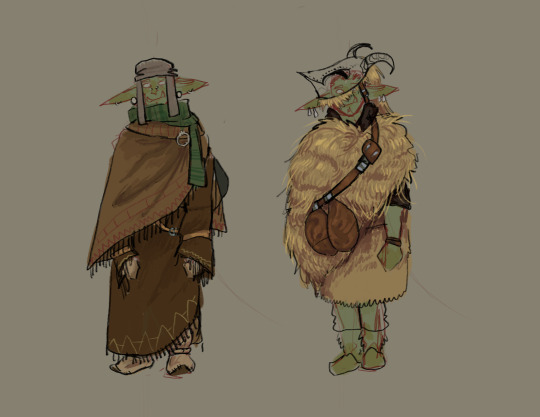
Here's a WIP for some clothes of the nomadic tribes of orcs, masks are very important to their culture and they wear a lot of bone jewelry. Metal working isn't really in their culture, seeing as they don't settle down for more than a season, so all metal you see is traded.
Nomadic orcs also are very plain, and don't use a lot of patterns.
I'm not explaining this well because there's a lot of stuff BUT the nomadic tribes are heavy in woodworking and trade. Though they mostly wear brown and green, this tends to be for religious and cultural reasons instead of lack of resources.
#vague worldbuilding#worldbuilding races#world building#worldbuilding#art#my art#worldbuilding art#orcs
22 notes
·
View notes
Text
Dungeon Meshi Human Interracial offspring (Mostly Spoiler Free)
As you might know, in Dungeon Meshi "human" is a term that refers to not only "tallman" (the equivalent of our world humans) but also Half-Foots, Ogres, Dwarves and Elves.
Besides the weird bone counting classification Kabru made I think one of the defining "human" aspects might be being able to have offspring with each other (unclear if that's possible at all between human and demi-human).
That said the Adventurer's Guide has some information about it that I wanted to share.
First, Humans in dungeon meshi are divided between short and long lived races, those are:
Long Lived Human Races:
Elf
Dwarf
Gnome
Short Lived Human Races:
Tallman
Half-foot
Ogre
As a general rule mixed offspring seems to be infertile but there's some exceptions.
Confirmed mixed race offspring that can leave descendants (Fertile offspring):
Tallman x Half-Foot
Tallman x Ogre
Dwarf x Gnome
An easy chart with the info! (It's not that complicated but its easier for me to see like this) (edit: added info what mixes have confirmed and speculated characters)
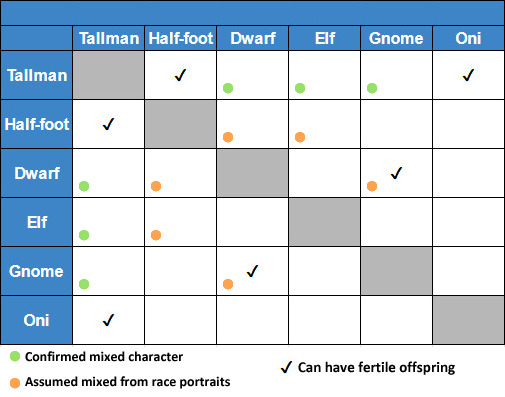
Seems like short-lived species can only have fertile offspring with each other and the same for long lived. Although there's no information about elves being able to have them with any other races, maybe because they live so much more than the other long-lived species (400 vs 200 & 240)
There's also no information about Ogres with Half-foot but I don't imagine the logistics to produce offspring would work there 😳
Another thing is that the Adventurer's Bible describes that the tallman have had an explosive growth due to having fertile offspring with half-foot and Ogres , so I wonder if that means their offspring are tallman too? Or are they still half-half-foot (a funny name) and half-Ogre? Unclear!
some of the confirmed mixed characters:
Corpse Retriever Leader - Half-Dwarf (Dwarf x Tallman)

Corpse Retriever Priest - Half-Gnome (Gnome x ? [Probably Tallman])

Fionil - Half-Elf (Elf x ? [Probably Tallman])
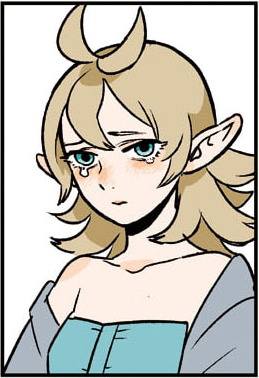
For the chart I added them as confirmed half-tallman due to their height/looks, I'm just being overzealous here.
Speculated mixed from the race portraits
In order: Half-Foot page: possibly half-dwarf | Elf Page: possibly half-foot or gnome mix | Dwarf page: possibly half-gnome.


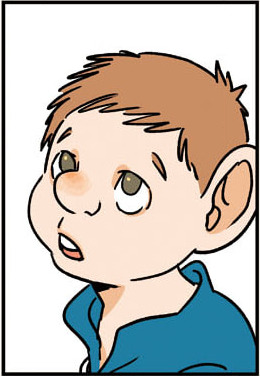
Sources and Spoilers Bellow the cut
From the page about tallman in the adventurer's bible (p134)

From the page about dwarves in the adventurer's bible (p140)

From the page about Ogres in the adventurer's bible (p140)

Page about 'other characters' (p098)
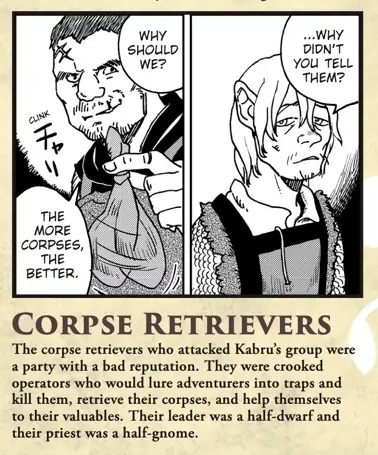
Fionil Profile (p096)

Spoiler And ofc I did not forget Marcille! I just don't want to tag this as spoilers since that would be pretty much the only spoiler
#dungeon meshi#adventurers bible#fantasy race#worldbuilding#mixed races#half-elf#half-dwarf#half-gnome#Fionil#Dwarves#half-foots#tallmen#elves#gnomes#Ogres#fantasy worldbuilding#longpost#long post#corpse retrievers#for referencing
343 notes
·
View notes
Text
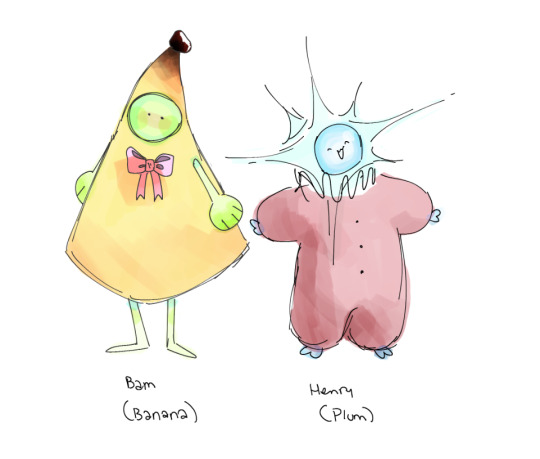


Have I shown yall my two sons (suns) yet
#starfruits#<- race name#my ocs#bam#henry#they were made by loosely looking at a friends worldbuilding ajdjsjjf#but could probably work standalone#my art
75 notes
·
View notes
Note
I'm a new player here and I've been trying to find some info on this through the tags but I wanted to ask: are hunter birth rates low in general or is more that people arent having 100% hunter kids? Idk why but in my mind I've been comparing them to pandas 😂
Hi there, that's a good question! The problem is multi-faceted, but simply put, Hunter birth rates aren't that high compared to other races, but not necessarily due to fertility reasons, if that makes any sense.
Here's a visual representation of pure-blooded Hunters who are capable of having pure-blooded Hunter kids:
⬤⬤⬤⬤⬤⬤⬤⬤⬤⬤
But consider that many of these will enter service as initiated exorcists, and of these, some won't survive the rite of passage (which takes place around 15) and others will be killed in the line of duty before they settle down, marry, and have kids:
⬤⬤⬤⬤⬤⬤⬤
Now consider that, of the ones who do marry, some won't marry other full-blooded Hunters, meaning the kids they do have won't manifest Hunter powers (which is actually the main concern here, not necessarily that the Hunter people will necessarily go extinct, numbers-wise, but that their powers will dwindle out of existence over time):
⬤⬤⬤⬤⬤
And then consider that Hunters have a shorter lifespan than most other races, with old age, illness, and death beginning to occur in the 50s and 60s, meaning the period of time they even have to settle down, raise healthy kids, and protect them until adulthood is drastically shortened, especially if they also want to pursue their own careers and livelihoods, requiring they either start having kids pretty young (which not many Hunters naturally want to do unless pressured to do so) or meaning many Hunter kids are left orphaned young, which also affects their own survival slightly:
⬤⬤⬤⬤
So all of those factors kind of come together to make it difficult to maintain a burgeoning population of pure-blooded, full-powered Hunters who inherit grace (again, not necessarily that people with Hunter blood are in decline). It should be noted that when two Hunters do start trying for kids, their fertility and reproductive rates are normal! It's just that the circumstances and odds leading to such a coupling (and the fact that more and more Hunters to fall in love with don't have full blood or grace with each passing year) are kind of stacked the opposite way, unless you make it your life's goal to have pure-blooded Hunter kids. That's why Halek faces such enormous pressure to marry Moonsilk and have kids: her clan is one of the last that have the high-born, pure Hunter blood that would suit Halek's line and would guarantee full-powered Hunter children, but it comes, of course, at the cost of Halek feeling like he doesn't have the luxury of falling in love with whomever he wants, since this urgent need has been impressed on him from an early age.
Hope that all makes sense! It would be hilarious if their problems were more panda-orientated ("we'll just show them videos and demonstrations of how to have sex! someone put on white wigs so they can learn, they're just clueless on how to do it") though lol!
40 notes
·
View notes
Text
Halflings are some of the only cultures to take care of people mutated by curses or otherwise corrupted by magic.
Halfling lycanthropes are usually just sent out to the woods to hunt during the fool moon, and are useally known in the community so that people can avoid them.
Zombies are thought of as sick instead of dead, and are useally kept in safe places by their families, sometimes used to guard crops if they need to.
Vampires are treated as those succumb to illness as well. They're useally fed the blood of their families to keep them healthy. Because of this they don't even see them as dangerous or evil.
Half orcs, half goblins, and half humans are useally accepted and respected for their strength, and commonly work jobs that require more physical prowess. Even if they were born from unfortunate circumstances.
Even people maddened by eldrich horrors are thought of as mentally and tend to be taken care of by their community, heavily decreasing the amount of cults.
Because of this, attacks by such "monsters" are rarer with halflings then any other race.
#196#worldbuilding#fantasy#writing#my worldbuilding#my writing#my thougts#halflings#halfling#hobbits#fantasy race#vampires#vampirism#vampyr#vampire#werewolves#werewolf#lycanthrope#lycanthropy#undead#zombie#eldrich#half orc#orc#world building
217 notes
·
View notes
Note
just asking, what if an iterator possibly gets too hot or cold? What happens if they can’t get to safer temps with out outside forces? What if they can’t get to safer temps at all?
Do you mean superstructures or puppet-bound iterators? I'm sure superstructures have a lot of failsafes to deal with temperature fluctuations, mostly via processing water intake. They're living saunas! They probably have an incredible resistance to both hot and cold, as evidence shows.
I'll talk about puppets here, but if you meant superstructures, well... a lot of what I'll say here could apply to superstructures too.
(For puppet-bound iterators, I am referring to my AU CDSS)
For heat: Puppet-bound iterators, like their former superstructure bodies, run hot and need to stay hydrated. They rely on liquid coolant that runs throughout their bodies. Ruptures in the coolant system are one of their many common problems, but with medical aid, they're not too serious. Many cases are self-healing, or the rupture will seal itself off and reroute around the blockage - like with collateral circulation. Leaks into essential systems are more of a concern than the actual loss of coolant. As long as they stay cool and drink water while waiting to get fixed, they tend to be fine.
If they are stuck in a hot region and can't escape, they'll suffer from dehydration, heat stroke, fried components, damage to organic tissue, seizures... pretty much what you'd expect. As a superstructure, Moon probably suffered from all this leading up to her collapse.
For cold: They're fairly resistant for a few reasons. One is the antifreeze in coolant. Another is the heat that they naturally produce. I'm thinking they have silicone-based skin, which is very cold resistant. They have hemocyanin, which tends to function better in extreme cold than hemoglobin. (Hemocyanin can also work at hotter temperatures. I have like a whole essay about this that I still intend to post lol.) However, the puppets have been modified to have more flexible and sensitive skin - dexterity in exchange for some durability. They're more susceptible to the perception of cold than they would be if they were a still a superstructure. Many of them also dislike snowscapes on principle, because they've been freezing their decaying metal butts off for centuries by the time CDSS happens.
Iterators in both forms are very moist, so if it's cold past their limits, their mechanical components will freeze. And like with hypothermia in fully organic beings, prolonged time in extreme cold will lead to tissue death and organ failure. Superstructures with fractured exteriors (direct exposure of internal parts to the cold air) are especially susceptible to this.
Misc theory about superstructures: Moon's superstructure was able to stay intact into Saint's era because she collapsed straight down into the water, preserving most of her shape. The canyon water could have provided the pressure and circulation she needed in the absence of gravity cores, as well as protection against land pests and insulation against the cold. Remnant slag could have her generate excess heat as well, which would keep the water surrounding her unfrozen. In a way, dying like that could have helped her live longer?!
Thanks for the question anon, this was very fun :P
#btw i am not a scientist. i have knowledge limited to what i have learned and what i can find on the internet#and i make jumps and assumptions sometimes#but you caught me in the middle of doing a CDSS writeup so I'm feeling kind of brave :^)#i love lore stuff both for canon rain world and for my au#but for my au i haven't really posted much substantial enough to ask questions about#and the universe for cdss while aligned with canon is also kind of... wild? so I've been vague out of nervousness#but there are other planets. there are other sapient races.#RW canon may very well not exist in a universe that has outer space but I build around the idea it is for the sake of my au#and i'm not sure how confusing or engaging that might be#i probably will post about it eventually though#because i'm having SO MUCH FUN with this au and this blog exists for me to have fun#but yeah. in the meantime i've only been showing small snippets and details about the iterators in cdss#ask#text#worldbuilding#cdss#anon#rw spoilers#headcanons#rambles
58 notes
·
View notes
Text
one thing they dont tell you about making original work is that Everything. has to be Named Things.
people. races. attacks. powers. Places. like enough. my brain is small.
#working on prismagic like Okay these people are from doppel yes but what is their Race's Name#and im just TIYADDDDD#txt#tfw to worldbuild you must Build the World.. head in hands rn
106 notes
·
View notes